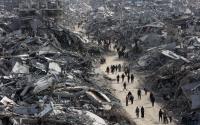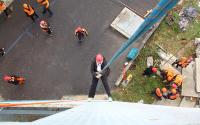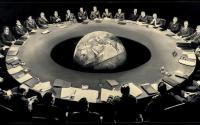I'm a cosmologist – my professional interests focus far away from the Earth. This might seem an incongruous viewpoint from which to address practical terrestrial issues. But I also believe that our civilisation may be threatened by 21st-century technology. A cosmic perspective sharpens this concern; it strengthens the imperative to cherish what Carl Sagan called our "pale blue dot" in the cosmos.
The stupendous timespans of the evolutionary past are now part of common culture. But many still perceive humanity as some kind of culmination; cosmologists, in contrast, are mindful that still vaster timespans lie ahead. The unfolding of intelligence and complexity could still be near its cosmic beginnings: in far-future aeons even more marvellous biodiversity could emerge. From this perspective, the present century seems the most crucial for Earth's history – it is a century when human choices and actions could ensure the perpetual future of life (which may lie not just on the Earth, but far beyond it); in contrast, through malign intent, or through misadventure, the next few generations could jeopardise life's potential, foreclosing its human and post-human future.
Viewed from deep space, our entire habitat of land, oceans and clouds is revealed as a thin, delicate glaze – its beauty and vulnerability contrasting with the stark and sterile moonscape on which the astronauts left their footprints. During nearly all its 4.5-billion-year history, Earth's appearance has altered very gradually. The only abrupt worldwide changes were triggered by major asteroid impacts or volcanic super-eruptions. Apart from those brief traumas, nothing happened suddenly – the continental land masses drifted; the ice cover waxed and waned; successions of new species emerged, evolved and became extinct.
But in just a tiny sliver of the Earth's history – the last one-millionth part, a few thousand years – the patterns of vegetation altered much faster than before. This signalled the start of agriculture – the imprint on the terrain of a population of humans, empowered by tools. The pace of change accelerated as human populations rose. Quite different transformations were then manifest; and these were even more abrupt. Within 50 years – little more than one-hundredth-of-a-millionth of the Earth's age – the amount of carbon dioxide in the atmosphere, which over most of Earth's history had been slowly falling, began to rise anomalously fast. The planet became an intense emitter of radio waves (the total output from all television, cellphone and radar transmissions.) And something else happened, unprecedented in Earth's history: metallic objects – albeit very small ones, a few tonnes at most – left the planet's surface and escaped the biosphere completely. Some were propelled into orbits around the Earth; some journeyed to the Moon and planets; a few even followed a trajectory that would take them deep into interstellar space, leaving the solar system for ever.
A race of scientifically advanced extraterrestrials watching our solar system could confidently predict Earth's final doom in another six billion years, when the Sun, in its death-throes, swells up into a "red giant" and vaporises anything remaining on our planet's surface. But could the extraterrestrials have predicted this unprecedented spasm less than half-way through the Earth's life (these human-induced alterations occupying, overall, less than a millionth of the elapsed lifetime and seemingly occurring with runaway speed)? If they continued to keep watch, what might these hypothetical aliens witness in the next hundred years? Will a final squeal be followed by silence? Or will the planet itself stabilise? And will some of the small metallic objects launched from the Earth spawn new oases of life elsewhere in the solar system, eventually extending their influences – via genetically engineered life or exotic machines – far beyond, creating an expanding "green sphere" that eventually pervades the whole galaxy? The answer will depend on how humans handle new technologies.
The 20th century brought us the bomb, and nuclear threats will never leave us. But 21st-century hazards, currently less familiar, could threaten humans and the global environment still more. Populations could be wiped out by lethal "engineered" airborne viruses; human character may be changed by new techniques far more targeted and effective than the nostrums and drugs familiar today; we may even one day be threatened by rogue nano-machines that replicate catastrophically, or by super-intelligent computers.
Conceivably, ordinary citizens could command the destructive capacity that, in the 20th century, was the frightening prerogative of the handful of people who held the reins of power in the nuclear superpowers. If there were millions of independent fingers on the button of a doomsday machine, then one person's act of irrationality, or even one person's error, could do us all in. That extreme situation is perhaps so unstable that it can never be reached, just as a very high house of cards can never be built. Long before technology reaches doomsday potential, millions will be empowered to trigger, at unpredictable times, events on the scale of the worst present-day terrorist outrages. An organised network of al-Qaida-type terrorists would not be required – just a fanatic, or a weirdo with the mindset of those who now design computer viruses. The ensuing disruption – its psychic and economic impact amplified by the media, and by the awareness that repeated instances are unpreventable – may become so pervasive that society corrodes and regresses. These risks can't be eliminated; indeed, it will be hard to staunch their growth without encroaching on some cherished personal freedoms.
By mid-century, nations may have drastically realigned; people may live very differently, their minds and personalities modified by medication, chip implants, and so forth. But one thing is unlikely to change: there will still be disaffected or embittered loners and dissident groups – very few, to be sure, but only one could be too many in an interconnected world vulnerable to new "bio" or "cyber" threats. Catastrophes could arise, even more worryingly, simply from technical misadventure.
The wider cosmos has a potential future that could even be infinite. But will this eternity be filled with ever more complex and subtle forms of life, or be as empty as the Earth's first sterile seas? The choice may depend on us, this century.
Sir Martin Rees's latest book, 'Our Final Century', is published by Heinemann on 1 May, price £17.99
http://news.independent.co.uk/world/science_medical/story.jsp?story=401637






